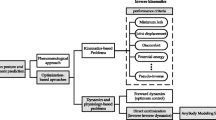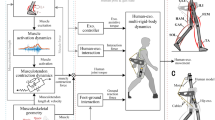Abstract
Musculoskeletal modeling of human motions such as cycling can help rehabilitation experts design and develop more effective therapy procedures. In the current study, a musculoskeletal model for the lower limb of cyclists is developed and controlled by designing a CPG network. EMG sensors were attached to the leg of five persons with different physical conditions, including professional and amateur cyclists, to record six muscles’ activities. Also, the joints’ trajectories have been measured. The skeletal dynamics of the skeleton of the lower limb are modeled using Lagrangian mechanics, and Hill’s modified nonlinear model is used for modeling the muscles. Central pattern generators are responsible for producing rhythmic motions in the human body, so to simulate and control the musculoskeletal model, a six-neuron CPG network is proposed and optimized by genetic algorithm. Simulations results show the RMSEs in tracking the joint trajectories as 0.0461, 0.0609, 0.1495, respectively, for the hip, the knee, and the ankle joint. The RMSEs for the VM, GT, BF, VL, TA and RF muscles are resulted as 0.0204, 0.0104, 0.0326, 0.0198, 0.0622, 0.002. Results show the good performance of the CPG as the controller of the central nervous system and also qualify this framework to be used in future studies.





Similar content being viewed by others
Abbreviations
- F, S, T:
-
Links: Thigh, Leg, Forefoot
- A, K, H:
-
Joints: Hip, Knee, Ankle
- CF, CS, CT :
-
Centers of mass
- d S, d F, d T :
-
Distances of the mass centers from the respective joints
- L F, L S, L T :
-
Lengths
- m F, m S, m T :
-
Masses
- I F, I S, I T :
-
Moments of inertia about the normal axis at the mass center
- g :
-
Gravitational acceleration
- F X, F Y :
-
Components of the pedal reaction force
- M A, M K, M H :
-
Joint torques
- θ F, θ S, θ T :
-
Link angles
- θ C :
-
Pedal angle
References
Bellman MJ, Cheng T-H, Downey RJ, Hass CJ, Dixon WE (2015) Switched control of cadence during stationary cycling induced by functional electrical stimulation. IEEE Trans Neural Syst Rehabil Eng 24:1373–1383
Bellman MJ, Downey RJ, Parikh A, Dixon WE (2016) Automatic control of cycling induced by functional electrical stimulation with electric motor assistance. IEEE Trans Autom Sci Eng 14:1225–1234
Billard A, Ijspeert AJ. (2000). Biologically inspired neural controllers for motor control in a quadruped robot Proceedings of the IEEE-INNS-ENNS International Joint Conference on Neural Networks. IJCNN 2000. Neural Computing: New Challenges and Perspectives for the New Millennium (Vol. 6, pp. 637–641): IEEE.
Buchli J, Iida F, Ijspeert AJ. (2006). Finding resonance: Adaptive frequency oscillators for dynamic legged locomotion 2006 IEEE/RSJ International Conference on Intelligent Robots and Systems (pp. 3903–3909): IEEE.
Chen J, Yu N-Y, Huang D-G, Ann B-T, Chang G-C (1997) Applying fuzzy logic to control cycling movement induced by functional electrical stimulation. IEEE Trans Rehabil Eng 5:158–169
Collins J, Stewart I (1993) Hexapodal gaits and coupled nonlinear oscillator models. Biol Cybern 68:287–298
Crespi A, Badertscher A, Guignard A, Ijspeert AJ (2005) AmphiBot I: an amphibious snake-like robot. Robot Auton Syst 50:163–175
Crespi A, Lachat D, Pasquier A, Ijspeert AJ (2008) Controlling swimming and crawling in a fish robot using a central pattern generator. Auton Robot 25:3–13
Duenas VH, Cousin CA, Parikh A, Freeborn P, Fox EJ, Dixon WE (2018) Motorized and functional electrical stimulation induced cycling via switched repetitive learning control. IEEE Trans Control Syst Technol 27:1468–1479
Duenas VH, Cousin CA, Parikh A, Dixon WE. (2016). Functional electrical stimulation induced cycling using repetitive learning control 2016 IEEE 55th Conference on Decision and Control (CDC) (pp. 2190–2195): IEEE.
Erdemir A, McLean S, Herzog W, van den Bogert AJ (2007) Model-based estimation of muscle forces exerted during movements. Clin Biomech 22:131–154
Farhoud A, Erfanian A (2014) Fully automatic control of paraplegic FES pedaling using higher-order sliding mode and fuzzy logic control. IEEE Trans Neural Syst Rehabil Eng 22:533–542
Ghanbari V, Duenas VH, Antsaklis PJ, Dixon WE (2018) Passivity-based iterative learning control for cycling induced by functional electrical stimulation with electric motor assistance. IEEE Trans Control Syst Technol 27:2287–2294
Grossberg S, Pribe C, Cohen MA (1997) Neural control of interlimb oscillations. Biol Cybern 77:131–140
Haghpanah SA, Farahmand F, Zohoor H (2017) Modular neuromuscular control of human locomotion by central pattern generator. J Biomech 53:154–162
Hayashibe M, Guiraud D (2013) Voluntary EMG-to-force estimation with a multi-scale physiological muscle model. Biomed Eng Online 12:1–18
Hermens HJ, Freriks B, Merletti R, Stegeman D, Blok J, Rau G, Hägg G (1999) European recommendations for surface electromyography. Roessingh Research Dev 8:13–54
Holliday W, Swart J (2022) A dynamic approach to cycling biomechanics. Phys Med Rehabil Clin 33:1–13
Holliday W, Theo R, Fisher J, Swart J (2019) Cycling: Joint kinematics and muscle activity during differing intensities. Sports Biomech 2:1–15
Hsueh PW, Tsai MC, Chen CL (2018) Stimulation interval evaluation for lower-limb cycling movement based on torque observer. Asian J Control 20:2318–2330
Hull M, Jorge M (1985) A method for biomechanical analysis of bicycle pedalling. J Biomech 18:631–644
Hunt KJ, Stone B, Negard N-O, Schauer T, Fraser MH, Cathcart AJ, Grant S (2004) Control strategies for integration of electric motor assist and functional electrical stimulation in paraplegic cycling: utility for exercise testing and mobile cycling. IEEE Trans Neural Syst Rehabil Eng 12:89–101
Ijspeert AJ (2001) A connectionist central pattern generator for the aquatic and terrestrial gaits of a simulated salamander. Biol Cybern 84:331–348
Ijspeert AJ, Crespi A, Ryczko D, Cabelguen J-M (2007) From swimming to walking with a salamander robot driven by a spinal cord model. Science 315:1416–1420
Kandel ER, Schwartz JH (2000) Department of biochemistry molecular biophysics Thomas Jessell, Steven Siegelbaum, and AJ Hudspeth Principles of neural science. McGraw-hill, New York, pp 49–50
Kawai H, Bellman MJ, Downey RJ, Dixon WE (2017) Closed-loop position and cadence tracking control for FES-cycling exploiting pedal force direction with antagonistic biarticular muscles. IEEE Trans Control Syst Technol 27:730–742
Kawai H, Bellman MJ, Downey RJ, Dixon WE. (2014). Tracking control for FES-cycling based on force direction efficiency with antagonistic bi-articular muscles 2014 American Control Conference (pp. 5484–5489): IEEE.
Kim C-S, Eom G-M, Hase K, Khang G, Tack G-R, Yi J-H, Jun J-H (2007) Stimulation pattern-free control of FES cycling: simulation study. IEEE transactions on systems, man, and cybernetics part C. Appl Rev 38:125–134
Lloyd DG, Besier TF (2003) An EMG-driven musculoskeletal model to estimate muscle forces and knee joint moments in vivo. J Biomech 36:765–776
Matsuoka K (1985) Sustained oscillations generated by mutually inhibiting neurons with adaptation. Biol Cybern 52:367–376
Murray WM, Delp SL, Buchanan TS (1995) Variation of muscle moment arms with elbow and forearm position. J Biomech 28:513–525
Pandy MG (2001) Computer modeling and simulation of human movement. Annu Rev Biomed Eng 3:245–273
Petrofsky JS, Heaton H III, Phillips CA (1983) Outdoor bicycle for exercise in paraplegics and quadriplegics. J Biomed Eng 5:292–296
Stein R, Leung K, Mangeron D, Oğuztöreli M (1974) Improved neuronal models for studying neural networks. Kybernetik 15:1–9
Thelen DG, Anderson FC, Delp SL (2003) Generating dynamic simulations of movement using computed muscle control. J Biomech 36:321–328
Wang C, Xie G, Wang L, Cao M (2011) CPG-based locomotion control of a robotic fish: using linear oscillators and reducing control parameters via PSO. Int J Innov Comput Info Control 7:4237–4249
Williamson MM (1998) Neural control of rhythmic arm movements. Neural Netw 11:1379–1394
Zignoli A, Biral F, Pellegrini B, Jinha A, Herzog W, Schena F (2017) An optimal control solution to the predictive dynamics of cycling. Sport Sci Health 13:381–393
Author information
Authors and Affiliations
Corresponding author
Ethics declarations
Conflict of interest
The author(s) declared no potential conflicts of interest with respect to the research, authorship, and/or publication of this article.
Rights and permissions
Springer Nature or its licensor (e.g. a society or other partner) holds exclusive rights to this article under a publishing agreement with the author(s) or other rightsholder(s); author self-archiving of the accepted manuscript version of this article is solely governed by the terms of such publishing agreement and applicable law.
About this article
Cite this article
Haghpanah, S.A., Zolfaghari, S.E., Eqra, N. et al. Musculoskeletal Modeling and Control of the Lower Limb in Cycling Using an Optimal Central Pattern Generator. Iran J Sci Technol Trans Mech Eng 47, 1121–1130 (2023). https://doi.org/10.1007/s40997-022-00566-1
Received:
Accepted:
Published:
Issue Date:
DOI: https://doi.org/10.1007/s40997-022-00566-1




